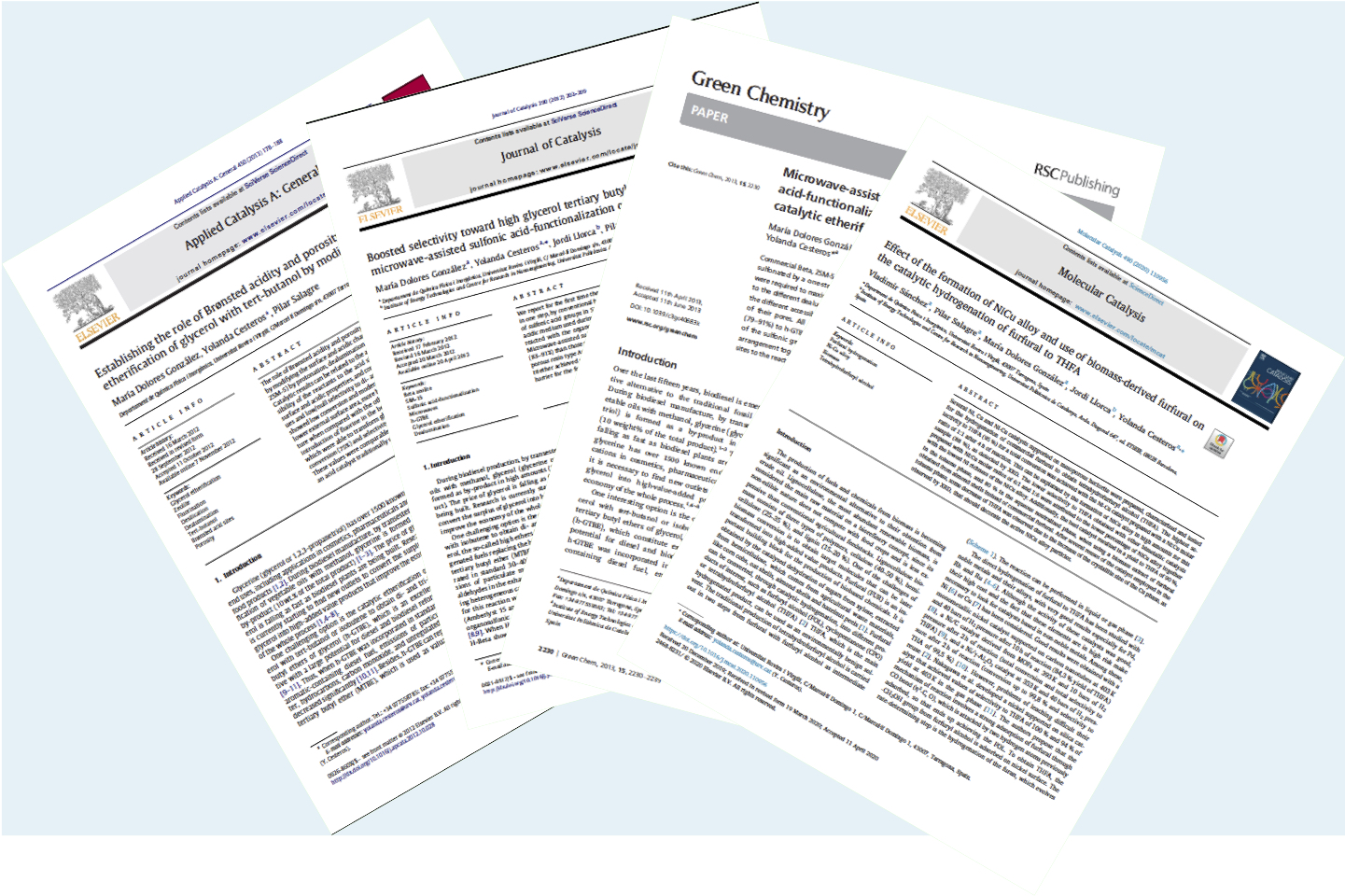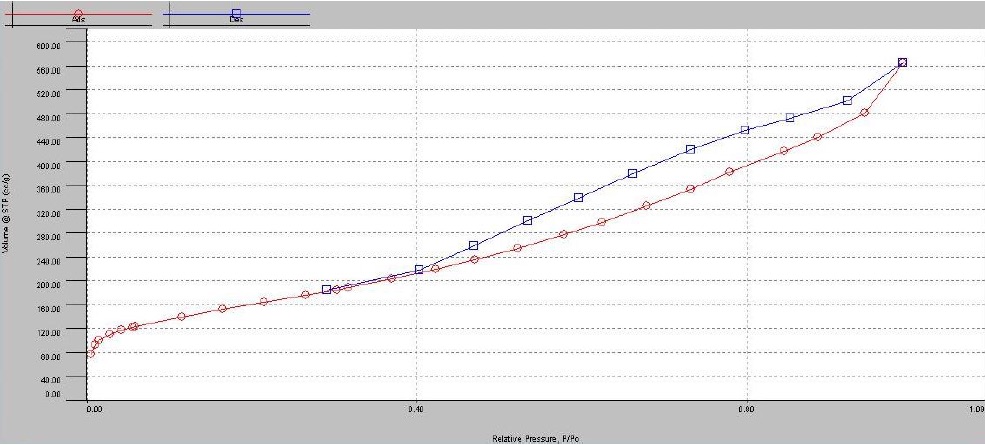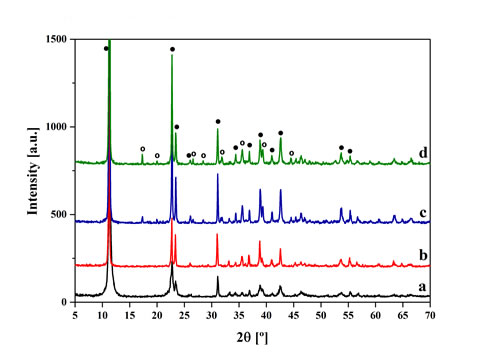
Catalytic valorization of lignocellulosic biomass wastes and catalytic revalorization of glycerine
-
Tuning the acid-base properties of layered double hydroxides for the selective obtention of cyclohexane and cyclohexanol in the hydrodeoxygenation of guaiacol, Chemical Engineering Journal, 2025
-
Selective production of levulinic acid from furfuryl alcohol over acid-modified zeolite catalysts, Applied Catalysis A-General, 2025
-
Synthesis of NiCuMgAl-layered double hydroxides using advanced microwave and ultrasound methods, APPLIED CLAY SCIENCE, 2024
- Acid-Modified Clays for the Catalytic Obtention of 5-Hydroxymethylfurfural from Glucose, ChemEngineering 2022, 6(4), 57
- Use of biobased crude glycerol, obtained biocatalytically, to obtain biofuel additives by catalytic acetalization of furfural using SAPO catalysts, Fuel 319 (2022) 123803.
- Cu boosting the collaborative effect of Ni and H+ in alloyed NiCu/saponite catalysts for hydrogenolysis of glycidol. Dalton Transactions 50(26) (2021) 9198-9207.
- Raw glycerol re-valuing through etherification with isobutylene: process design and techno-economical assessment. Journal of Industrial and Engineering Chemistry 94 (2021) 159-165.
- Catalytic hydrogenation of furfural to tetrahydrofurfuryl alcohol using competitive nickel catalysts supported on mesoporous clays. Applied Catalysis A: General (2021) 117903
- Effect of the formation of NiCu alloy and use of biomass-derived furfural on the catalytic hydrogenation of furfural to THFA. Molecular Catalysis, 490 (2020) 110956.
- Editorial Catalysts: Special issue on "microwave-assisted catalysis" Catalysts 10(8),842, (2020) 1-4.
- Microwave- assisted furfural production using hectorites and fluorohectorites as catalysts. Catalysts, 9(9), (2019) 706.
- Effect of using microwaves for catalysts preparation on the catalytic acetalization of glycerol with furfural to obtain fuel additives. Open Chemistry 16 - 1 (2018) 386 - 392.
- Boosted selectivity towards glycerol carbonate using microwaves vs conventional heating for the catalytic transesterification of glycerol. Applied Clay Science. 156 (2018) 110-115.
- Hydrogenolysis of glycidol as alternative route to obtain selectively 1,3-propanediol using MOx modified Ni-Cu catalysts supported on acid mesoporous saponite. ChemCatChem 9 - 19 (2017) 3670-3680.
- Glycidol hydrogenolysis on a cheap mesoporous acid saponite supported Ni catalyst as alternative approach to 1,3-propanediol synthesis. Applied Catalysis A: General 538 (2017) 91-98.
- Effect of the preparation conditions on the catalytic activity of calcined Ca/Al-layered double hydroxides for the synthesis of glycerol carbonate. Applied Catalysis A: General 536 (2017) 9-17.
- CaAl-layered double hydroxides as active catalysts for the transesterification of glycerol to glycerol carbonate. Applied Clay Science 132-133 (2016) 216-222.
- Influence of acid-base properties of calcined MgAl and CaAl layered double hydroxides on the catalytic glycerol etherification to short-chain polyglycerols Chemical Engineering Journal 264 (2015) 547-556.
- Effect of hierarchical porosity and fluorination on the catalytic properties of zeolite Beta for glycerol etherification. Applied Catalysis A: General 473 (2014) 75-82.
- Tuning the acidic and textural properties of ordered mesoporous silicas for their application as catalysts in the etherification of glycerol with isobutene. Catalysis Today 227 (2014) 171-178.
- Microwave-assisted synthesis of sulfonic acid-functionalized microporous materials for the catalytic etherification of glycerol with isobutene. Green Chemistry 15(8) (2013) 2230-2239.
- Sulfonic-acid functionalized aerogels as high resistant to deactivation catalysts for the etherification of glycerol with isobutene. Applied Catalysis B: Environmental 136-137 (2013) 287-293.
- Establishing the role of Brønsted acidity and porosity for the catalytic etherification of glycerol with tert-butanol by modifying zeolites. Applied Catalysis A: General 450 (2013) 178-188.
- Boosted selectivity toward high glycerol tertiary butyl ethers by microwave-assisted sulfonic acid-functionalization of SBA-15 and beta zeolite. Journal of Catalysis 290 (2012) 202-209.
- Use of delaminated hectorites as supports of copper catalysts for the hydrogenolysis of glycerol to 1,2-propanediol, Chemical Engineering Journal 179 (2012) 302-311
Preparation and characterization of catalytic materials
Using microwaves and ultrasounds
- Assessment through FT-IR of surface acidity and basicity of hydrocalumites by nitrile adsorption. Applied Clay Science, 180 (2020) 105180.
- Mapping Temperature Distribution Generated by Photothermal Conversion in Graphene Film Using Er,Yb:NaYF4 Nanoparticles Prepared by Microwave-Assisted Solvothermal Method. Frontiers in Chemistry, 7 (2019) paper 88.
- Microwave Engineering for Synthesizing Clays and Modifying Properties in Zeolites. Microwave Engineering of Materials: From Mesoscale to Nanoscale, Pan Stanford Publishing Pte. Ltd (USA). ISBN: 978-981-4669-42-9 (Hardcover), 978-981-4669-43-6 (eBook), 6 (2016) 165-196.
- Potential of Cu-saponite catalysts for soot combustion Catalysis Science and Technology 6 (2) (2016) 507-514.
- Ultrasound-assisted reconstruction and delamination studies on CaAl layered double hydroxides. Applied Clay Science 118 (2015) 116-123.
- Microwave synthesis of delaminated acid saponites using quaternary ammonium salt or polymer as template. Study of pH influence. Applied Clay Science 114 (2015) 20-30.
- Use of polymer as template in microwave synthesis of saponite. Study of several factors of influence. Applied Clay Science 87 (2014) 170-178.
- Effect of microwaves, ultrasounds and interlayer anion on the hydrocalumites synthesis. Microporous Mesoporous Materials 199 (2014) 117-124.
- Fast aging treatment for the synthesis of hydrocalumites using microwaves. Applied Clay Science 80-81 (2013) 313-319.
- Evaluation of hectorites, synthesized in different conditions, as soot combustion catalysts after impregnation with copper, Applied Clay Science 77-78 (2013) 40-45.
- Effect of the La(OH)3 preparation method on the surface and rehydroxylation properties of resulting La2O3 nanoparticles. Journal of Nanoparticle Research 15 (3) (2013) art. nº 1479.
- Ultrasounds and microwave-assisted synthesis of mesoporous hectorites. Microporous and Mesoporous Materials 171 (2013) 24-34.
- Comparison of dealumination of zeolites beta, mordenite and ZSM-5 by treatment with acid under microwave irradiation. Microporous and Mesoporous Materials 144 (1-3) (2011) 162-170.
- Microwave-assisted synthesis of saponite. Applied Clay Science, 48 (2010) 26-31.
- Preparation of pure hectorite using microwaves. Physics Procedia, 8 (2010) 88-93.
- Effect of microwaves on the surface and acidic properties of dealuminated zeolites. Physics Procedia, 8 (2010) 104-108.
- Acidity properties of Ni-exchanged mordenites prepared with and without microwaves. Applied Catalysis A: General, 368 (2009) 163-169.
- Effect of microwaves in the dealumination of mordenite on its surface and acidic properties. Microporous and Mesoporous Materials, 118 (2009) 341-347.
- Fast microwave synthesis of hectorite. Applied Clay Science, 43 (2009) 103-107.
- Microwave effect during aging on the porosity and basic properties of hydrotalcites. Microporous and Mesoporous Materials, 101(3) (2007) 363-373.
- CO2 adsorption in several aged hydrotalcites and calcined hydrotalcites to study the influence of using microwaves during the aging step on their basic properties. Adsorption science & technology, 25 (2007) 143-154.
Using conventional methods
- Microporous high-surface area layered CeO2. Microporous and Mesoporous Materials, 101 (2007) 363-373.
- A reexamination of the adsorption of CO and nitriles on alkali-metal mordenites: characterization of multiple interactions. Physical Chemistry Chemical Physics, 7 (2005) 2526-2533.
- Fourier Transform Infrared Spectroscopic Study of the Adsorption of CO and Nitriles on Na-Mordenite: Evidence of a New Interaction. Journal of Physical Chemistry B, 109 (2005) 915-922.
- Design of NiO-MgO materials with different properties. Physical Chemistry Chemical Physics, 6 (2004) 858-864. Highlighted in ChemInform (2004) 35(19).
- Comparative study of the morphology and surface properties of nickel oxide prepared from different precursors. Solid State Ionics, 156 (2003) 233-243.
- Tailoring properties of advanced materials of interest in catalysis. Recent Research Developments in Solid State Ionics, 1 (2003) 207-235. ISBN: 81-7895-069-3, KERALA, INDIA.
- Simple Synthesis and Characterization of Several Nickel Catalyst Precursors. Journal of Chemical Education, 79 (2002) 489-491.
- A new route to the synthesis of fine-grain gibbsite. Chemistry of Materials, 13 (2001) 2595-2600.
- Several factors affecting Al-MCM-41 synthesis. Microporous and mesoporous materials, 43 (2001) 171-179.
- Preparation and characterization of different phases of aluminium trifluoride. Chemistry of Materials, 12 (2000) 1148-1155.
- Study of preparation conditions of NiO-MgO systems to control the morphology and particle size of the NiO phase. Solid State Ionics, 134 (2000) 229-239.
- Preparation and characterization of several high-area NiAl2O4. Study of their reducibility. Chemistry of Materials, 12 (2000) 331-335.
- Several factors affecting faster rates of gibbsite formation. Chemistry of Materials, 11 (1999) 123-129.
- Structural characterization of NiO doped with several caesium loadings. Journal of Molecular Catalysis, 119 (1997) 77-85.
Catalytic isomerization and dehydrogenation reactions
- Layered Double Hydroxides for the Catalytic Isomerization of Linoleic Acid to Conjugated Linoleic Acids (CLAs) ChemEngineering 3(1) (2019) 30.
- Effect of catalyst acidity and porosity on the catalytic isomerization of linoleic acid to obtain conjugated linoleic acids (CLAs), Chemical Engineering Journal 183 (2012) 459-465.
- Omega-3 fatty acid ethyl ester from a simple catalytic non-oxidative dehydrogenation of a biobased oleochemical. Catalysis Communications, 8 (2007) 319-323.
- Isomerisation of styrene oxide to phenylacetaldehyde by fluorinated mordenites using microwaves. Journal of Catalysis, 232 (2005) 239-245.
Hydrogenation of styrene oxide to 2-phenylethanol
- Ni nanoparticles supported on microwave-synthesised hectorite for the hydrogenation of styrene oxide. Applied Catalysis A: General 408 (1-2) (2011) 31-37
- Ni nanoparticles supported on microwave-synthesised saponite for the hydrogenation of styrene oxide. Applied Clay Science 53 (2) (2011) 212-219.
- Control of the basicity in Ni-MgO systems. Influence in the hydrogenation of styrene oxide. Catalysis Letters, 122 (2008) 259-266.
- Effective catalysts, prepared from several hydrotalcites aged with and without microwaves, for the clean obtention of 2-phenylethanol. Applied Catalysis A: General, 331 (2007) 19-25.
- Hydrogenation of styrene oxide in the presence of supported platinum catalysts to produce 2-phenylethanol. Journal of Molecular Catalysis A: Chemical, 261 (2007) 98-103.
- Preparation of 2-phenylethanol by catalytic selective hydrogenation of styrene oxide using palladium catalysts. Journal of Molecular Catalysis A: Chemical, 239 (2005) 215-221.
- High-selective Ni-MgO catalysts for a clean obtention of 2-phenylethanol. Applied Catalysis A-General, 272 (2004) 125-132.
Preparation of metal oxide and metal nanoparticles to be applied in photonic and optical devices
- Thiol-capped CdTe quantum dots hosted in saponites RSC Adv. 6 (2016) 104793- 104798.
- Strategies to tailor the UV absorption band of Eu3+:La2O3 down-shifting nanocrystals. SPIE-The International Society for Optical Engineering 8438 (2012) art. nº 843804.
- Effect of thermal annealing on the kinetics of rehydroxylation of Eu3+:La2O3 nanocrystals. Inorganic Chemistry 51(11) (2012) 6139-6146.
- Polymer composite P3HT:Eu3+ doped La2O3 nanoparticles as a down converter material to improve the solar spectrum energy. Optical Materials 22 (2011) 1120-1123.
- Photoluminescence and Cathodoluminescence of Eu:La2O3 nanoparticles synthesized by several methods. Physics Procedia, 8 (2010) 114-120.
- Sol-gel Pechini synthesis and optical spectroscopy of nanocrystalline La2O3 doped with Eu3+. Optical Materials, 32 (2010) 1686-1692.
- Exploring the possibilities of Eu3+:La2O3 nanoparticles as an approach for down-conversion processes in solar energy systems. Photonics for Solar Energy Systems III. Proceedings of SPIE, 7725 (2010) 77250V-1-77250V-11.
Hydrodechlorination of chlorinated aromatic compounds and CFCs
- Catalytic hydrodechlorination of 1,2,4-trichlorobenzene over Pd/Mg(Al)O catalysts. Applied Catalysis B: Environmental, 87 (2009) 70-77.
- Characterization and catalytic properties of several KMg1-XPdXF3 with perovskite-like structures for the hydroconversion of CHClF2. Applied Catalysis B: Environmental, 42 (2003) 251-264.
- Effect of the aluminium fluoride phase for the Cl/F exchange reactions in CCl2F2 (CFC-12) and CHClF2 (HCFC-22). Applied Catalysis B: Environmental, 40 (2003) 259-269.
- Use of new Ni/Al-MCM-41 catalysts for the exhaustive hydrodechlorination of 1,2,4-trichlorobenzene. Catalysis Letters, 79 (2002) 83-88.
- KMg1-XPdXF3 with perovskite-like structures as precursors for the catalytic hydroconversion of CCl2F2 and CHClF2. Catalysis Letters, 77 (2001) 141-146.
- Palladium hydrotalcites as precursors for the catalytic hydroconversion of CCl2F2 (CFC-12) and CHClF2 (HCFC-22). Applied Catalysis B: Environmental, 32 (2001) 167-179.
- Hydrodechlorination of 1,2,4-trichlorobenzene on nickel based catalysts prepared from several Ni/Mg/Al hydrotalcite-like precursors. Applied Catalysis B: Environmental, 32 (2001) 25-35.
- Catalytic hydrodechlorination of 1,2,4-trichlorobenzene on Ni/Al-MCM-41 catalysts. Studies in Surface Science and Catalysis, 135 (2001) 233. ISBN 0-444-50238-6.
- Catalytic behaviour of several Ni/NiAl2O4 catalysts in the hydrogenation of 1,2,4-trichlorobenzene and benzene to cyclohexane. Studies un Surface Science and Catalysis, 130C (2000) 2069-2074. ISBN 0-444-50480.
- Synthesis and characterization of several Ni/NiAl2O4 catalysts active for the 1,2,4-trichlorobenzene hydrodechlorination. Applied Catalysis B: Environmental, 25 (2000) 213-227.
- TPD study about the surface modification of some Ni/spinel catalysts in the hydrodechlorination of 1,2,4-trichlorobenzene. Influence on hydrogenation ability. Catalysis Letters, 67 (2000) 147-153.
- Effect of the alumina phase and its modification on Ni/Al2O3 catalysts for the hydrodechlorination of 1,2,4-tricholobenzene. Applied Catalysis B: Environmental, 22 (1999) 135-147.
- Catalytic Hydrodechlorination on several alumina supported nickel catalysts. Chemical Industry and Environmental II, 2 (1996) 667-673. ISBN 88-8202-000-2.
- Surface structure of bulk nickel catalysts, active in the gas-phase hydrodechlorination reaction of aromatics. Journal of the Chemical Society, Faraday Transactions, 92 (1996) 2811-2816.
Catalytic epoxidation and oxidation reactions
- Defect-induced strategies for the creation of highly active hydrotalcites in base-catalyzed reactions. Journal of Catalysis, 252 (2007) 249-257.
- Effects of morphology and cesium promotion over silver nanoparticles catalysts in the styrene epoxidation. Journal of Materials Science, 10 (2007) 3307-3314.
- Propene epoxidation by nitrous oxide over Au-Cu/TiO2 alloy catalysts. Journal of Molecular Catalysis A: Chemical, 274 (2007) 159-168.
- Sensitivity of styrene oxidation reaction to the catalyst structure of silver nanoparticles. Applied Surface Science, 252 (2005) 793-800.
- Epoxidation of styrene with hydrogen peroxide using hydrotalcites as heterogeneous catalysts. Applied Catalysis A-General, 272 (2004) 175-185.
- Different morphologies of silver nanoparticles as catalysts for the selective oxidation of styrene in the gas phase. Chemical Communications, 7 (2004) 846-847.
Catalytic aldol condensation reactions
- Aldol condensations of campholenic aldehyde and MEK over activated hydrotalcites. Applied Catalysis B: Environmental, 70 (2007) 577-584.
- Synthesis, characterization and catalytic activity of metal nanoparticles in the selective oxidation of olefins in gas phase. The Journal of Experimental Nanoscience, 1 (2006) 399-418.
- Synthesis of silver-gold alloy nanoparticles by a phase-transfer system. Journal of Materials Research, 21 (2006) 105-111.
- Styrene epoxidation over cesium promoted silver nanowires catalysts. Journal of Molecular Catalysis A:Chemical, 258 (2006) 346-354.
- Nanoplatelet-based reconstructed hydrotalcites: towards more efficient solid base catalysts in aldol condensations. Chemical Communications, (2005) 1453-1455.
- Study of alkaline-doping agents on the performance of reconstructed Mg-Al hydrotalcites in aldol condensations. Applied Catalysis A: General, 281 (2005) 191-198.
- Aldol Condensations Over Reconstructed Mg-Al Hydrotalcites: Structure-Activity Relationships Related to the Rehydration Method. Chemistry-A European Journal, 11 (2005) 728-739.
- Supported Choline Hydroxide (ionic liquid) as Heterogeneous Catalyst for Aldol Condensation Reactions. Chemical Communications, (2004) 1096-1097. Highlighted in ChemInform (2004) 35(36) and in Green Chemistry (2004) G68.
- Cu/Ni/Al layered double hydroxides as precursors of catalysts for the west air oxidation of phenol aqueous solutions. Applied Catalysis B: Environmental, 30 (2001) 195-207.
Catalytic hydrogenation of nitriles
- Evolution of several Ni and Ni-MgO catalysts during the hydrogenation reaction of adiponitrile. Applied Catalysis A-General, 272 (2004) 353-362.
- Nickel-Magnesia catalysts: an alternative for the hydrogenation of 1,6-hexanedinitrile. Journal of Catalysis, 209 (2002) 202-209.
- Nickel and nickel-magnesia catalysts active in the hydrogenation of 1,4-butanedinitrile. Journal of Catalysis, 197 (2001) 210-219.
- Characterization and catalytic properties of several La/Ni and Sr/Ni solids. Applied Catalysis A: General, 152 (1997) 249-269.
Catalytic reduction of nitrates
- Catalytic reduction of nitrate on Pt-Cu and Pd-Cu on active carbon using continuous reactor. The effect of copper nanoparticles. Applied Catalysis B: Environmental, 62 (2006) 77-85
Separation of N2 and O2 from air
- Study of the influence of several mordenite modifications on its N2 and O2 adsorption properties. Journal of Physical Chemistry B, 108 (2004) 5359-5364.
- Catalytic valorization of lignocellulosic biomass wastes and catalytic revalorization of glycerine
- Preparation and characterization of catalytic materials
- Catalytic isomerization and dehydrogenation reaction
- Hydrogenation of styrene oxide to 2-phenylethanol
- Preparation of metal oxide and metal nanoparticles to be applied in photonic and optical devices
- Hydrodechlorination of chlorinated aromatic compounds and CFCs
- Catalytic epoxidation and oxidation reactions
- Catalytic aldol condensation reactions
- Catalytic hydrogenation of nitriles
- Catalytic reduction of nitrates
- Separation of N2 and O2 from air




